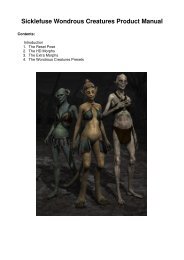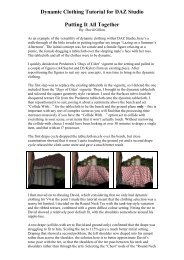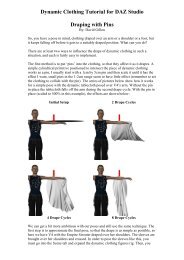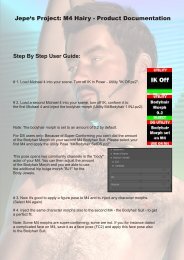Documentation for the use of the Advanced Ambient Light ... - Daz 3D
Documentation for the use of the Advanced Ambient Light ... - Daz 3D
Documentation for the use of the Advanced Ambient Light ... - Daz 3D
You also want an ePaper? Increase the reach of your titles
YUMPU automatically turns print PDFs into web optimized ePapers that Google loves.
The parameters in <strong>the</strong> Occlusion group adjust <strong>the</strong> appearance and quality <strong>of</strong> <strong>the</strong> occlusion based shadows.There are several speed enhancements, such as adaptive sampling and primitive hitmode. Theseenhancements may not look good in all situations.Fortunately, beca<strong>use</strong> <strong>of</strong> <strong>the</strong> advanced lighting controls <strong>of</strong> <strong>the</strong> light, you can selectively illuminate different objectswith different settings or different lights. This allows <strong>for</strong> <strong>the</strong> speed enhancements to be turned <strong>of</strong>f <strong>for</strong> surfaceswhere higher quality settings are needed yet keep <strong>the</strong> fast rendering optimizations <strong>for</strong> surfaces where <strong>the</strong>enhancements will have no negative effect.Adaptive Sampling - When enabled <strong>the</strong> light will <strong>use</strong> a lower occlusion sample rate in areas which mayrequire less samples. In <strong>the</strong>se areas <strong>the</strong> renderer will <strong>use</strong> a sample count as low as 1/4 <strong>the</strong> AO Samplessetting. As shadow quality may suffer, it is recommended that this setting only be <strong>use</strong>d with an AOSamples setting <strong>of</strong> 64 or higher.AO Color - Sets <strong>the</strong> hue <strong>of</strong> occlusion based shadows. Black will usually give <strong>the</strong> most believable resultsbut having <strong>the</strong> option to change <strong>the</strong> shadow color allows <strong>for</strong> more creative freedom.AO Strength - Sets <strong>the</strong> strength, or contrast, <strong>of</strong> occlusion based shadows. A setting <strong>of</strong> 0% will disableocclusion calculations.AO Samples - Declares <strong>the</strong> highest number <strong>of</strong> rays which will be cast from a surface point to check <strong>for</strong>occlusion. Higher samples generally create shadows which are less grainy though overall quality or speedis determined by a combination <strong>of</strong> AO Samples, AO Shading Rate and AO Max Error.Alternate Samples - This setting is <strong>the</strong> same as AO Samples but an alternate rate which can be <strong>use</strong>d onsurfaces flagged conditionally with options in <strong>the</strong> <strong>Light</strong>ing Control Group.Subsurface Samples - This is ano<strong>the</strong>r alternate sample rate which will only be <strong>use</strong>d in <strong>the</strong> pre-render,subsurface scattering calculation pass in scenes containing subsurface shaders. The AO Samples settingwill still be <strong>use</strong>d <strong>for</strong> <strong>the</strong> diff<strong>use</strong> portion <strong>of</strong> <strong>the</strong>se shaders but subsurface calculation can have a speedbenefit from using a lower sample count with little noticeable image quality loss.AO Shading Rate - Similar to "Shading Rate" located in DAZ Studio's render settings, this parameteradjusts how frequently to sample occlusion. Higher values render considerably faster but <strong>the</strong> results tendto look washed out and detail may be lost.The setting is roughly based on geometry and screen space. At an AO Shading Rate <strong>of</strong> 1 <strong>the</strong> geometryunder every image pixel will cast occlusion rays. At a setting <strong>of</strong> 16, rays will be cast from <strong>the</strong> surfaces only,approximately, every 16th pixel and <strong>the</strong> result interpolated over <strong>the</strong> area <strong>of</strong> <strong>the</strong> shading grid.This setting is strongly tied to AO Max Error.AO Max Error - A speed versus quality adjustment which sets <strong>the</strong> maximum allowable interpolation error<strong>of</strong> <strong>the</strong> AO Shading Rate. Provided <strong>the</strong> AO Shading Rate setting is greater than 1, higher AO Max Errorvalues will render substantially faster. In my tests <strong>the</strong>re is rarely a noticeable difference at AO Max Errorsettings above 0.5.AO Max Distance - A limit to how far away (in centimeters) any two surfaces will will contribute toocclusion. For instance, <strong>the</strong> default setting <strong>of</strong> 250 will tell <strong>the</strong> occlusion ray not consider any shadowcontribution if <strong>the</strong> ray travels 250cm without hitting ano<strong>the</strong>r object.







